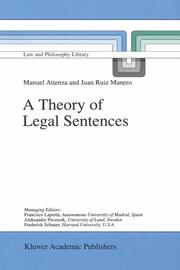-
Zusatztext
-
InhaltsangabePreface. I: Mandatory Norms: Principles and Rules. 1. Introduction. Types of Principles. 2. Principles and Rules. 3. The Explanatory, the Justificatory and the Legitimatory Dimension of Principles. Appendix: Reply to our Critics. 1. Mandatory Rules as Peremptory Reasons, and Principles as Non-Peremptory Reasons; the `closed' or `open' Configuration of the Conditions of Application. 2. Principles and Full Compliance. II: Power- Conferring Rules. 1. Introduction. 2. What Power- Conferring Rules Are Not. 3. What Power-Conferring Rules Are. Appendix: Reply to our Critics. 1. Introduction. 2. Critique of our Critique of the Deontic (or Prescriptivist) Conception. 3. Are we Treating the Conceptualist Thesis Fairly? 4. Problems with our Conception. III: Permissive Sentences. 1. Permission in Contemporary Legal Theory. 2. Reformulating the Problem. 3. Some Conclusions. Appendix: A Note on Constitutional Permission and Basic Rights. IV: Values in the Law. 1. Introduction. 2. Two Conceptions of Criminal Norms. 3. The Double-Faced Character of Norms and Value Judgments. 4. Types of Norms and Types of Values. V: The Rule of Recognition. 1. Introduction. 2. Jurists and the `Normative Value' of the Constitution. 3. The Rule of Recognition as Ultimate Norm. 4. Changing the Rule of Recognition without Rupturing Legal Continuity? 5. A Host of Problems. 6. Who Shapes the Rule of Recognition? 7. The Conceptual, Directive and Evaluative Dimensions of the Rule ofRecognition. The Rule of Recognition and the Exclusionary Claim of the Law. Why Accept the Rule of Recognition? 8. How Many Rules of Recognition? Certainty and Penumbra in the Rule of Recognition. VI: Conclusions. 1. Introduction. 2. A Classification of Legal Sentences: Table 1. 3. A Comparative Analysis of the Different Types of Sentences: Table 2. Table I: Classification of Sentences. Table II: Comparative Analysis of Different Types of Sentence. Bibliography. Index of Names.
-
-
Autorenportrait
- InhaltsangabePreface. I: Mandatory Norms: Principles and Rules. 1. Introduction. Types of Principles. 2. Principles and Rules. 3. The Explanatory, the Justificatory and the Legitimatory Dimension of Principles. Appendix: Reply to our Critics. 1. Mandatory Rules as Peremptory Reasons, and Principles as Non-Peremptory Reasons; the `closed' or `open' Configuration of the Conditions of Application. 2. Principles and Full Compliance. II: Power- Conferring Rules. 1. Introduction. 2. What Power- Conferring Rules Are Not. 3. What Power-Conferring Rules Are. Appendix: Reply to our Critics. 1. Introduction. 2. Critique of our Critique of the Deontic (or Prescriptivist) Conception. 3. Are we Treating the Conceptualist Thesis Fairly? 4. Problems with our Conception. III: Permissive Sentences. 1. Permission in Contemporary Legal Theory. 2. Reformulating the Problem. 3. Some Conclusions. Appendix: A Note on Constitutional Permission and Basic Rights. IV: Values in the Law. 1. Introduction. 2. Two Conceptions of Criminal Norms. 3. The Double-Faced Character of Norms and Value Judgments. 4. Types of Norms and Types of Values. V: The Rule of Recognition. 1. Introduction. 2. Jurists and the `Normative Value' of the Constitution. 3. The Rule of Recognition as Ultimate Norm. 4. Changing the Rule of Recognition without Rupturing Legal Continuity? 5. A Host of Problems. 6. Who Shapes the Rule of Recognition? 7. The Conceptual, Directive and Evaluative Dimensions of the Rule ofRecognition. The Rule of Recognition and the Exclusionary Claim of the Law. Why Accept the Rule of Recognition? 8. How Many Rules of Recognition? Certainty and Penumbra in the Rule of Recognition. VI: Conclusions. 1. Introduction. 2. A Classification of Legal Sentences: Table 1. 3. A Comparative Analysis of the Different Types of Sentences: Table 2. Table I: Classification of Sentences. Table II: Comparative Analysis of Different Types of Sentence. Bibliography. Index of Names.
Detailansicht
A Theory of Legal Sentences
Law and Philosophy Library 34
ISBN/EAN: 9780792348566
Umbreit-Nr.: 4893928
Sprache:
Englisch
Umfang: xiii, 194 S.
Format in cm:
Einband:
gebundenes Buch
Erschienen am 30.11.1997
Auflage: 1/1997


